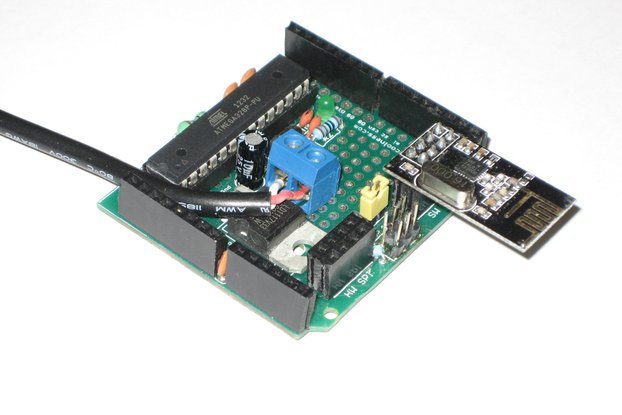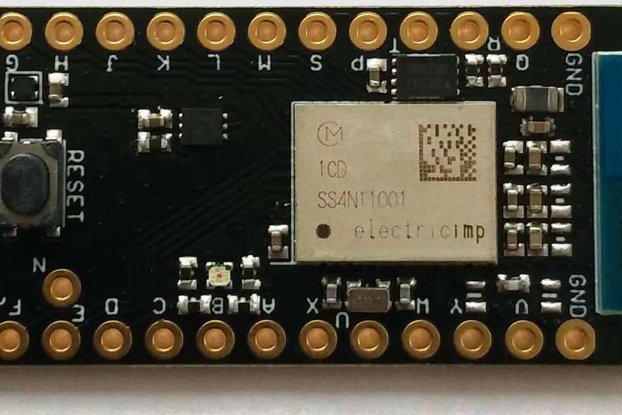Energy monitoring module to easily incorporate quality AC energy measurements into your next Arduino or Raspberry Pi project
Designed by Upbeat Labs in United States of America
Buy with confidence.
Our Tindie Guarantee protects your purchase from fraud. Learn More
Dr. Wattson - What is it? Dr. Wattson is an Energy Monitoring Module from Upbeat Labs that allows you to easily incorporate high quality AC energy monitoring and measurements in your next project! It…
Read More…Dr. Wattson is an Energy Monitoring Module from Upbeat Labs that allows you to easily incorporate high quality AC energy monitoring and measurements in your next project! It is coupled with easy to use Arduino and Python libraries that together with the Dr. Wattson Module make getting quality AC energy data like RMS Current, RMS Voltage, Power Factor, Line Frequency, Active/Reactive/Apparent Power a breeze, with just a couple of lines of code.
The unit comes pre-calibrated, enabling you to start taking quality measurements from 90-240v, at either 50 or 60 Hz, and for currents up to 15A. You don't need any additional CT/VT or other components.
Dr. Wattson is based on the MCP39F521, a single-phase power monitoring chip from Microchip.
The board is designed to be tolerant of different logic levels using bi-directional level shifting, so it can be used with both 5v and 3.3v systems.
Dr. Wattson caters to both the novice and advanced user! The libraries are very comprehensive and allow for advanced usage, while still making it intuitive and easy to use for the common use-case.
If you're familiar with the MCP39F521 and its calibration and other commands it supports, you can also change the measurement range by changing the burden resistors on the board and recalibrating the board (essentially treating the Dr. Wattson board as a breakout board for the MCP39F521).
Whether you want to measure small standby power consumption or larger loads, Dr. Wattson has you covered. Boasting a 4000:1 Dynamic Range, and capable of 0.1% accuracy, the MCP39F521 is a versatile chip, allowing you great flexibility with measurements. Dr. Wattson takes that flexibility and makes it easy to use! Dr. Wattson comes calibrated to measure currents from 5mA up to 15A.
[Version 1 of the Dr. Wattson board came calibrated for measurements between 1mA and 4A (with a 15A conversion option you could do yourself or we did it for you for a small fee).We have made measurements up to 15A the default in the V2 unit. If you want to measure down to lower currents (like measuring standby current usage), you can change the burden resistors and apply the calibration settings we provide for that lower range. Instructions will be provided!]
A comprehensive, yet easy-to-use Arduino library means you can easily integrate the Dr. Wattson board into your application and jump right away into quality energy measurements and other functionality with your favorite flavor of Arduino (Uno, Mega, Nano, etc!).
A comprehensive, yet easy-to-use Python library using smbus2 means you can now easily hook up the Dr. Wattson board to your Raspberry Pi (or other SBC such as BeagleBone Black) and integrate it into your next project.
There are quite a few code samples to get you started as well as give you some inspiration. You have code samples to show basic usage, like
Getting energy data (VRMS, IRMS, Line Frequency, Power Factor, Active Power, Reactive Power, Apparent Power)
Energy Accumulation (turn on energy accumulation and energy consumption (and generation) is tracked in the background without intervention, allowing your microcontroller/single-board-computer to go to sleep or do other stuff!)
Events (get notified when Voltage Sag/Surge happens, or Over-Power/Over-Current conditions happen using external interrupts and using the library to easily read which triggering event condition happened)
Writing to/Reading from EEPROM (The MCP39F521 has 256 16-bit words of EEPROM that is organized in 32 pages for a total of 512 bytes. Convenience methods in the library let you write to and read from this memory easily!)
ZCD (Get Zero Cross Detection notifications via external interrupts. This is useful, for example, for controlling a dimmer switch (and reporting the energy saved by dimming!))
and more advanced examples such as
Integration with AWS IOT - build your own internet-connected energy monitor!
Energy data logger - log data to an SD card with log rotation
Energy monitor with OLED screen - monitor energy and display information on an OLED screen
Environmentally friendly and high-quality ENIG finish (lead free) with lead-free solder and wide high-voltage-traces and quality components that are rated to 12A or more! The isolated sensor design using current and voltage sensing transformers ensures that the board itself is not in the path of the high current load, for safer usage and development.
It includes 4 mounting holes (M2.5) to enable you to put it into a safe enclosure. We also offer an optional enclosure for the Dr. Wattson board.
Solder jumpers on the board enable you to pick from 4 possible I2C addressing schemes, which helps when you may have a conflict with another device. It also allows you to control 4 of these boards from a single MCU using the same I2C bus - monitor energy consumption and usage from 4 different loads!
Use the Zero Cross Detector (ZCD) output to orchestrate any synchronization like firing a Triac for dimming, or making a clock based on your AC line frequency! (just kidding ... there are more efficient ways to make a clock! :-) - you can however certainly use the line frequency data as a measure of the quality of your AC power)
The event pin gives you output indication on the presence of configured events of interest, like voltage surge/sag, over-current, over-power.
Configure the events of interest you would like to monitor for via the Arduino/Python library, and get notifications by connecting these pins to any externally interruptible pin in your MCU. Using the library, you can then query the board to find out which event occurred.
While the board is powered by 3.3v, it uses bi-directional level shifting on all IO pins, so you can use a 5v system or a 3.3v logic system without any modifications or need for level shifting. Just set the Vin (V-input) pin on the Dr. Wattson board to your MCU/SBC logic level voltage - e.g. 5v for Arduino Uno, 3.3v for Raspberry Pi, and Dr. Wattson will take care of everything else.
You are purchasing the Dr. Wattson Energy Monitoring Board. In addition, you will need the following:
I worked on a Smart Outlet project called BuffI the Ampere Slayer (see my presentation from Maker Faire 2017 in San Mateo, CA - https://youtu.be/LzQakUzzlg4). Part of the work that was done on that project was to enable quality energy monitoring, including the ability to measure small standby power consumption.
I thought that a well-calibrated breakout board/module that provides quality energy monitoring as a subcomponent that can be easily integrated into other systems/projects with would be very useful to the Maker community. I decided to create the Dr. Wattson board and its associated libraries to help facilitate that.
No country selected, please select your country to see shipping options.
No rates are available for shipping to .
Enter your email address if you'd like to be notified when Dr. Wattson Energy Monitoring Board - V2 can be shipped to you:
Thanks! We'll let you know when the seller adds shipping rates for your country.
| Shipping Rate | Tracked | Ships From | First Item | Additional Items |
|---|---|---|---|---|
|
:
|
| Quantity | Price |
|---|---|
| 1-9 | $80.00 |
| 10-19 | $80.00 |
| 20+ | $75.00 |
Product: (5.00)
Documentation: (3.00)
Shipping: (5.00)
Communication: (5.00)
Raymond | Aug. 16, 2018
Miwa | Aug. 7, 2018
Buy with confidence.
Our Tindie Guarantee protects your purchase from fraud. Learn More
Mountain View, CA, United States of America
Ships from United States of America.
2 Reviews | 49 Orders

$299.00
Free Shipping!

$50.00
Free Shipping!

$4.95
Free Shipping!

$29.95
Free Shipping!
By clicking Register, you confirm that you accept our Terms & Conditions
We recognize our top users by making them a Tindarian. Tindarians have access to secret & unreleased features.
We look for the most active & best members of the Tindie community, and invite them to join. There isn't a selection process or form to fill out. The only way to become a Tindarian is by being a nice & active member of the Tindie community!
